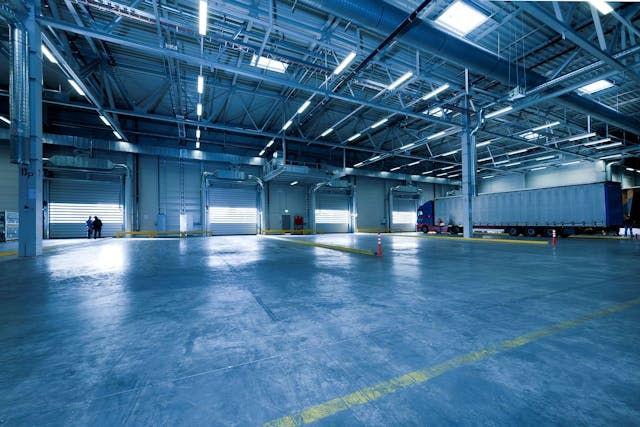The Future of Industrial Real Estate in the E-Commerce Economy 📦🚚
- EPS Team

- 2 days ago
- 5 min read
Industrial real estate used to sit quietly in the background of the commercial property market—solid, stable, but rarely in the spotlight. Today, it’s the star performer of commercial real estate (CRE). The rise of e-commerce, changes in global supply chains, and consumer demand for faster delivery have propelled warehouses, logistics centers, and distribution hubs into one of the hottest and most dynamic asset classes. 🏢✨
In 2025 and beyond, industrial real estate is not only keeping pace with retail shifts but actively shaping them. From the surge in last-mile logistics facilities to the explosive growth in cold storage and automated smart warehouses, the sector’s transformation is redefining how goods move, how businesses invest, and how property managers lead.
This blog explores where industrial real estate is headed in the e-commerce economy—with real data, major trends, challenges, investment opportunities, and the leadership strategies needed to thrive.

Why Industrial Real Estate Is Booming 📊
Industrial real estate’s growth is driven by a combination of consumer behavior, logistics demand, and CRE investment trends. Let’s look at the key numbers fueling this sector:
E-commerce penetration: Online sales represented 15.6% of total U.S. retail sales in 2024 (U.S. Census Bureau), up from just 10% in 2019. That’s nearly $1.3 trillion in e-commerce spending last year alone. 📈
Warehouse demand: Prologis projects that the U.S. will need 1 billion square feet of new warehouse space by 2030 to meet e-commerce and supply chain needs.
Vacancy rates: Despite significant construction activity, U.S. industrial vacancy rates held steady at 5.3% in Q2 2024 (Cushman & Wakefield)—a sign of ongoing demand.
Rental growth: Industrial rents grew 7% year-over-year in 2024, with certain hot markets like Southern California seeing double-digit increases. 💰
Cold storage needs: Online grocery sales are projected to hit $146 billion by 2025 (Mercatus), creating unprecedented demand for temperature-controlled warehouses. ❄️
These figures show that industrial real estate isn’t just “keeping up” with e-commerce—it’s a core enabler of the online shopping revolution.
How E-Commerce Is Reshaping Industrial Space 📦✨
E-commerce has shifted the way industrial real estate is designed, located, and operated. No longer is a single massive warehouse on the outskirts of town enough to support customer demand. Instead, companies are developing multi-tiered logistics ecosystems.
Last-Mile Delivery Hubs 🏙️
Located near dense urban centers, these smaller facilities ensure same-day or next-day delivery.
For example, Amazon’s “delivery stations” are popping up across secondary U.S. markets to shorten delivery windows.
Mega Fulfillment Centers 🏗️
Giant warehouses—sometimes over 1 million square feet—serve as regional hubs for inventory storage and automated order processing.
Walmart, Target, and Amazon all continue to expand these high-tech distribution facilities.
Cold Storage Warehouses ❄️🥬
The surge in grocery e-commerce and meal-kit delivery has created an urgent need for cold chain logistics.
Currently, only 3% of U.S. industrial real estate is cold storage-capable, leaving a supply gap that investors are eager to fill.
Reverse Logistics Facilities 🔄
Roughly 16.5% of e-commerce sales result in returns (National Retail Federation).
Specialized warehouses are needed to process, inspect, and redistribute returned goods efficiently.
Together, these shifts have redefined the role of industrial real estate—from simple storage to a critical component of supply chain resilience and customer experience.
Key Industrial Real Estate Trends to Watch in 2025 and Beyond 🔮
1. Urban Logistics and Last-Mile Expansion 🚴♂️
Consumers expect faster shipping at no extra cost, pushing retailers to establish smaller, strategically located warehouses near cities.
According to CBRE, over 70% of retailers plan to expand last-mile delivery capabilities in the next five years.
This trend is driving creative redevelopment—old malls and big-box retail stores are being converted into logistics hubs.
2. Automation and Robotics in Warehouses 🤖
With labor shortages and rising wages, companies are investing in automation.
Automated storage and retrieval systems (AS/RS), robotics, and AI-driven inventory tracking reduce human error and increase speed.
A 2024 JLL report found that automation can reduce warehouse operating costs by up to 40%.
3. Sustainability in Industrial CRE 🌱
Warehouses are going green—adding solar panels, EV-charging infrastructure, and energy-efficient designs.
LEED-certified industrial facilities often command 10–20% rental premiums as corporate tenants seek to meet ESG goals.
4. Cold Chain Expansion ❄️
Online grocery is expected to account for 20% of grocery sales by 2026 (Supermarket News).
Cold chain facilities are no longer niche—they’re essential infrastructure.
Yet, building them is expensive, with construction costs averaging 2–3x higher than standard warehouses.
5. Rise of Secondary and Tertiary Markets 🌎
High costs in traditional hubs like New Jersey, Los Angeles, and Chicago are pushing investors into secondary markets.
Cities like Columbus, Indianapolis, Phoenix, and Dallas are thriving due to lower land costs and access to key transportation corridors.
Industrial absorption in secondary markets grew 15% faster than national averages in 2024 (Cushman & Wakefield).
Challenges Facing Industrial Real Estate ⚠️
Despite its growth, industrial real estate faces several headwinds:
Rising Construction Costs 🏗️
Industrial construction costs increased 18% between 2020 and 2023 (Turner & Townsend).
High costs for steel, labor, and land acquisition delay development timelines.
Land Scarcity Near Cities 🏙️
Urban land availability is shrinking. Developers must get creative, often redeveloping obsolete retail or office space into industrial hubs.
Infrastructure Strain 🚧
The U.S. supply chain depends on aging transportation infrastructure. Without modernization, bottlenecks could hinder industrial growth.
Labor Shortages in Logistics 👷♂️
Warehousing and transportation roles face turnover rates above 40% annually (U.S. Bureau of Labor Statistics).
Recruiting and retaining warehouse staff remains a top challenge, even with automation.
Investment Opportunities in Industrial Real Estate 💡
For investors and developers, industrial CRE is packed with opportunity. Here are five areas to watch:
Build-to-Suit Projects 🔑
Custom facilities designed for major tenants (Amazon, FedEx, UPS) provide long-term, stable leases.
Cold Storage Development ❄️
Demand outpaces supply by a wide margin, offering premium rental rates and low vacancy.
Secondary Market Growth 🌍
Lower entry costs and increasing demand make markets like Phoenix and Columbus attractive.
Retrofit of Obsolete Assets 🔧
Converting outdated warehouses or vacant malls into logistics hubs creates high returns.
Public-Private Partnerships 🤝
Infrastructure investment projects can help expand industrial capacity while reducing risk for developers.
The Leadership Factor in Industrial Real Estate 👩💼👨💼
Industrial real estate success isn’t just about land and logistics—it’s about leadership and operations.
Executive roles in supply chain management ensure facilities operate efficiently and align with long-term corporate goals.
Property managers must handle the complexity of automation, sustainability upgrades, and cold chain requirements.
Talent development strategies are critical for reducing turnover and building stable logistics teams.
In short, the right leadership helps industrial assets achieve maximum performance, while poor staffing leads to costly inefficiencies.
Looking Ahead: The Industrial Future 🚀
By 2030, e-commerce is expected to make up nearly 25% of U.S. retail sales. This growth guarantees that industrial real estate will remain at the center of commerce and consumer life.
The sector’s future will be shaped by:
Urban infill logistics
Sustainability innovations
Advanced warehouse automation
Cold chain expansion
Flexible multi-use facilities
Industrial real estate is no longer just about warehouses—it’s about building the physical backbone of the digital economy.
Conclusion 🏁
Industrial real estate has evolved from a back-office asset into the lifeblood of the e-commerce economy. With online retail sales climbing, demand for last-mile hubs, mega distribution centers, cold storage, and smart warehouses will only increase. Investors and operators who embrace these shifts—and prepare for rising costs, labor challenges, and sustainability demands—will position themselves for long-term success.
At the end of the day, strong leadership drives these opportunities forward. Partnering with a trusted commercial real estate staffing firm like Executive Property Staffing ensures companies secure the executives, property managers, and logistics leaders needed to optimize industrial operations and capture value in this fast-changing market.




Comments